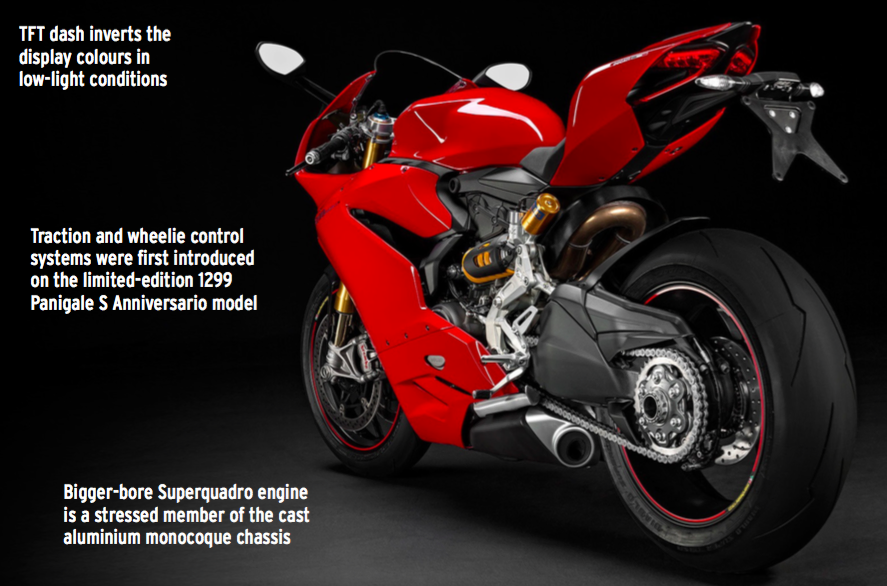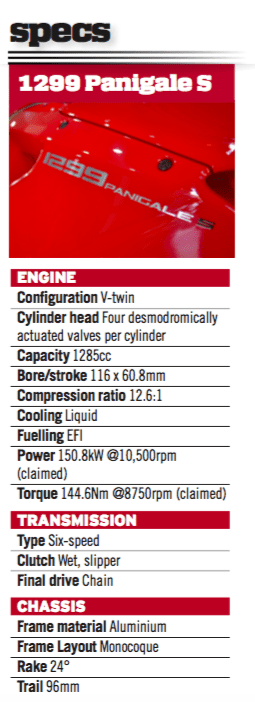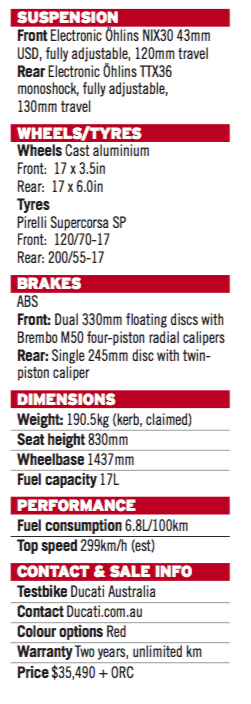There aren’t many motorcycles in the world that when you turn up to your local barber for a quick haircut he insists you park the motorcycle in the shop so all the workers and customers can admire it. That’s exactly what happened when I arrived on a Ducati 1299 Panigale S for my monthly trim – everyone thought it was just too beautiful to leave outside on the street.
This is a motorcycle I enjoy looking at as much as I enjoy riding it. The styling is very similar to the outgoing 1199 (the only difference being the larger numbered decal on the side), but when you get the styling so right in the first place, why change it? The front is aggressively styled with the headlights tucked out of sight, the tank is beautifully sculpted and the see-through tail is a work of art.

As the number on the fairing indicates, the new Panigale has a larger engine, the powerhouse is now a whopping 1285cc, liquid-cooled, four-valves per cylinder, desmodromic twin. Power is claimed to be an impressive 150.8kW at 10,500rpm, while torque is a monstrous 144.6Nm at a relatively low 8750rpm. This torque figure gives the Panigale nearly 30Nm over other 1000cc superbikes on the market – something that really shines on the road.
There are three default riding modes – Race, Sport and Wet – that can be changed on the fly. These modes not only change engine output but also power delivery, throttle response, traction control, ABS levels, engine braking and the electronic suspension. If you like to tinker and can’t help but fiddle with options, all the settings can be changed independently of the three default riding modes.
Race mode has an insanely direct throttle response and on the road it can be a little snatchy down low, but as the revs rise it becomes intuitive. It doesn’t have the high-end acceleration rush of the four-cylinder superbikes, but a look at your speedo confirms it is more than there. Though a little rough below 2000rpm, above that vibes are minimal and the engine uber-smooth.
As you’d expect, Road mode is the pick for the road, offering the perfect balance of hard-edged performance with docile manners. ABS operates on both ends of the motorcycle – unlike Race mode where just the front wheel ABS is used.
Wet mode knobbles power and increases the safety aids, while traction control can be adjusted on the fly via buttons on the left handlebar, which is a welcome addition.

A stand-out feature of the new Panigale is its bidirectional quick-shifter – all you need the clutch for is taking-off and coming to a stop. I was a little sceptical about how well it would match the downchanges, but it does a better job than most people could do themselves. It was so great, I found myself unnecessarily changing gears just to use it.
Without a doubt, the 1299 Panigale is the loudest stock motorcycle I have ridden and it’s one that definitely doesn’t need an aftermarket exhaust fitted – well done Ducati!
The ride is firm, but not unbearable on the road. You can feel the suspension softening as you cycle through the modes, and the active suspension does take the harshness out of larger bumps. Go into corners hard on the brakes all the way until you are powering out and the suspension constantly changes to ensure the Panigale is as balanced as it can be. Tip-in is super-fast, mid-corner stability good and corner exit predicable – no surprises are thrown at you. Flickability from side to side is really good thanks to wide handlebars and a low 190kg wet weight.
The brakes are strong and predicable, with good front lever feel. The ABS pulsates quickly when called upon and the whole motorcycle remains balanced, allowing you to ride the brakes deep into turns without the fear of a front-end washout.
A shortfall of the Panigale is the exhaust system that wraps around under the seat. On a warm day the heat can only be described as unbearable – it’s like sitting on a heater coil.
There might be better bang-for-buck superbikes out there, but most people buying a Panigale know it has a good chance of holding its value.
With rumours that the new Panigale may be a V-four, this could be the last truly great V-twin. The engine is sublime, the electronics fantastic and even when you’re not riding it, this bike looks as good standing still as it does on the road.
By Alex Penklis


















